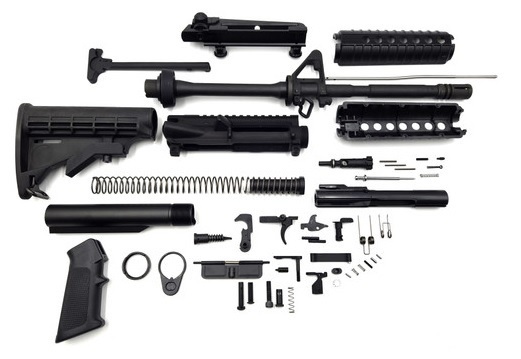Building with an AR15 Kit: What to Know
Feb 11th 2025
There are plenty of reasons why some shooters might prefer to build a rifle with an AR15 kit rather than buying an assembled rifle, some of which will be covered here.
Take a look through this list of frequently asked questions, see if yours are answered, and get in touch with us if you have additional questions or need more information before you buy.
- What does an AR15 kit include?
A quality AR15 kit will include everything you need minus the stripped lower receiver. This includes all upper and lower components and hardware, including springs and pins. As a result, you won’t need an FFL transfer to buy a kit.
- Is there anything an AR15 doesn’t include?
Yes, most AR15 kits will not include a stripped lower receiver as that is the part that is serialized and regulated by the ATF as an actual firearm. You will need a stripped lower to complete the build and this will require you to fill out a 4473, submit for a NICS check, and an FFL transfer.
Some build kits also don’t come with parts like magazines or slings, so be aware of that and make sure you check the list of included components before buying.
- What is an 80% lower?
An 80% lower, also sometimes referred to as an 80 lower or a receiver blank, is a receiver that has not had the slots milled out for the trigger assembly and the fire control unit (FCU). As a result, an 80% lower cannot be used to complete an assembled rifle until machining has been completed. Some states have outlawed possession of 80% lowers, however, so consult a firearms lawyer in your area before proceeding if that is your plan.
- What tools do I need to assemble an AR15?
You actually really only need a few basic tools to assemble a rifle from a kit, though it does help to have some specialized ones. Among the tools you should have are a torque wrench, armorer’s wrench, punch set, a set of hex keys, screwdrivers, and a hammer. Stick with a brass or nylon hammer to avoid damaging the gun.
You’ll also need a clean, clear working space, and it helps to have a receiver vise block to hold the gun in place while you’re working on it.
- What caliber/cartridge should I choose?
That’s really up to you but one of the most popular calibers is .223 Remington (or 5.56, which offers basically the same performance). These intermediate cartridges are low-cost, highly available, lightweight, low recoil, and can be very accurate, even at extremely long ranges. This makes them popular for training, sporting applications, and even personal defense.
Other popular AR chamberings include .300 BLK, 7.62x39mm, .308, and .50 Beowulf, among a bunch of others. You can also build an AR around .22LR and there are PCCs, or pistol-caliber carbines, chambered in 9mm.
- What are the advantages of building from a kit?
Building from a kit can be cost-effective, and it is also enjoyable and educational. If you build your own rifle you won’t be able to help but learn a whole bunch about the gun, which knowledge will prove useful whenever it’s time to troubleshoot issues, make repairs, or consider upgrades. Also, building from a kit can help you skirt some of the shortages that have plagued the gun industry over the past few years.
- Should I just buy an assembled rifle?
That really depends. If you don’t like tinkering, don’t care about the process, and really just want to get a rifle that you can start shooting as soon as you bring it home, then sure.
- What length barrel should I choose?
That depends on your intended application. Shorter barrels, like 16” barrels, offer greater maneuverability and surer handling, especially in cramped spaces. Longer barrels, such as 18” and 20” barrels are heavier, but they also add a little extra FPS to the bullet, so some prefer them for hunting or long-range shooting. You might also consider an AR-15 pistol kit, which offers rifle-caliber firepower in a much more compact package.
- What’s the best muzzle device for pairing with a kit?
If your AR15 kit comes with a threaded barrel, and almost all do, it will also probably come with a flash hider. However, both muzzle brakes and suppressors offer greater value. Muzzle brakes help cut back on felt recoil and muzzle flip; suppressors are NFA items, but they also cut back on felt recoil while also substantially reducing the volume of the gun.
- What handguard/rail system is best?
Some build kits come with tropical handguards, which don’t really offer any mounting points. Modern alternatives will likely have either a Picatinny, M-LOK or KeyMod handguard. All of these offer a ton of room for accessorization, but the latter two are lighter and more comfortable to handle than Pic rails.

Your Next AR15 Kit Is Here
SARCO is not just your source for gun parts, it’s also your source for AR15 kits. Take a look at the previous option, which contains everything you need to get started minus tools and a stripped lower receiver, and get in touch with us directly if you have any questions before you get started.

